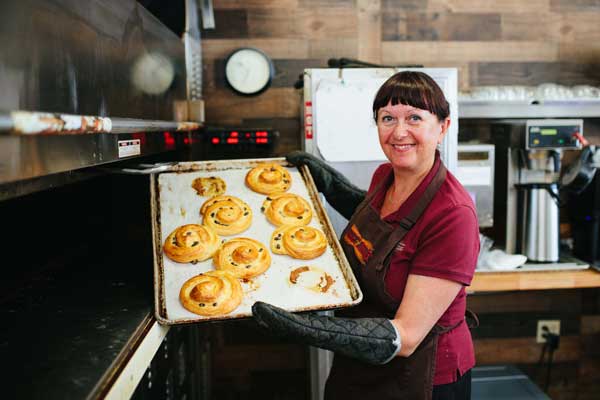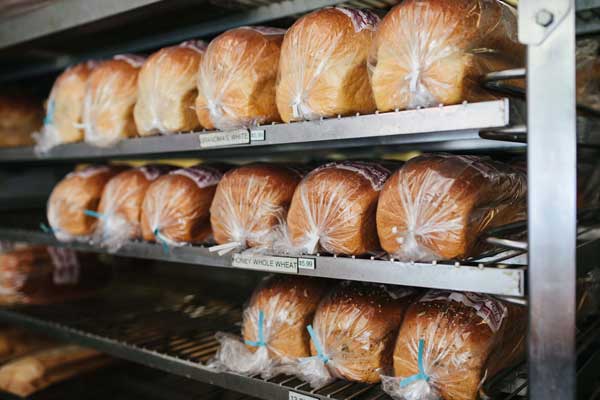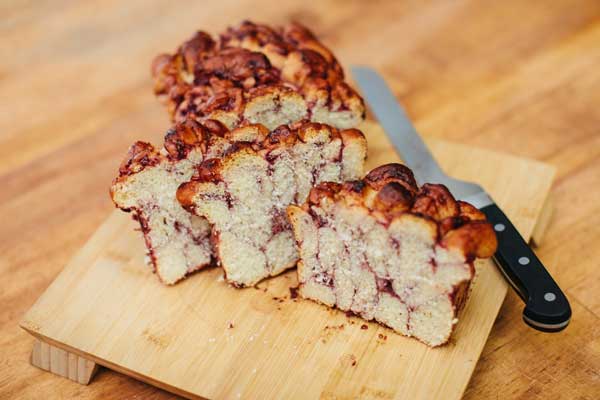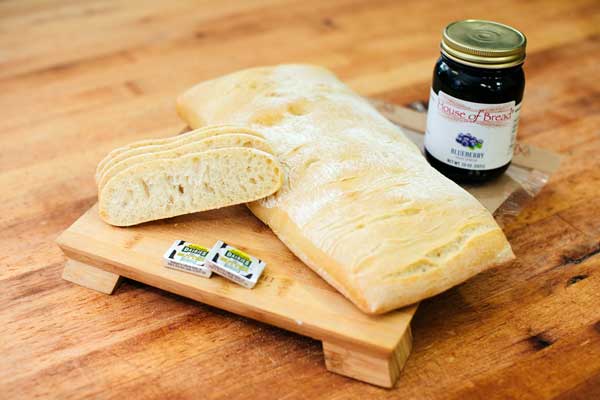ALL RISE
Artisan breadmakers slice through location challenges and misconceptions.
Written by Heidi Bethel
Photos by Jen Schmidt
A staple found in pantries around the globe, the almighty bread has been around, in some form or another, since the Stone Age. Though today’s version is as evolved as the humans digesting it, several truths about bread remain: It’s still made with the same basic ingredients, it still fills us up and satisfies us, and it can be modified to highlight fresh, local ingredients.
The dawn of time
According to A Brief History of Bread presented by the History Channel, bread is the most widely consumed food in the world and has been for quite some time. At least 30,000 years ago, prehistoric man began using hot stones to fry a nutrient-rich gruel made from water and grains, and voilà! They had bread.

Atwell pulls a tray of freshly baked pastries out of the oven
Nathalie Atwell, owner of House of Bread in Reno, recognizes the significant role bread has played throughout history.
“Not only is it an important source of carbohydrates, but it’s also portable and compact, which helps to explain why it has been an integral part of our diets for thousands of years.”
But the vast difference between the bland staple eaten by cavemen and the hearty, delicious versions we favor today can be attributed to three modern innovations: leavening, or the process of making it light and fluffy; milled flour; and mechanical slicing.
A bad rap
Present-day innovations and discoveries have led to the common use of chemically treated ingredients; the gluten-free, no-carbohydrate diet craze; and a general expectation among consumers for inexpensive, long-lasting food products. While processed, commercial bread products line the shelves of many grocery stores, artisan breadmakers have taken a stand — making healthy, delicious breads with care and selling them inside quaint local bakeries, from food trucks, and even out of their homes.
When Atwell and her husband, Tim, were considering opening a French-style bakery, she insisted on using quality ingredients and an authentic process. Then, coincidentally, the previous House of Bread owners, who had successfully operated the business for 17 years, were ready to retire.
“The stars aligned,” Atwell recalls. “The main thing that attracted me to this bakery is what they didn’t use. The European way is not to use any treated flour. When used in commercial breads, it cuts cost and extends shelf life, but your body doesn’t process it well, and it has created this anti-bread movement. We don’t use any chemical preservative in any of our breads. We use honey in our bread as a natural preservative, and all the fillings are made in house.
“Our white bread uses four ingredients,” Atwell adds. “Good flour, water, salt, and yeast, and that’s it. Wonder bread will sit on the shelves for months before it molds. You have to wonder what’s in it, and look at what that does to the human body.”
Atwell says she often hears folks complain that bread is leading to obesity.
“People blame getting fat on bread. They shouldn’t blame the bread; they should blame the ingredients and the quality,” she says. “The idea that food is supposed to be cheap, in every sense of the word, is creating a bad expectation all around.”
Paul and Cheyenne Schat, owners of Paul Schat’s Bakery in Carson City*, have been up against the various stigmas associated with bread since the late ’80s, when they took over the original family business in Mammoth, Calif. In 2003, they decided to relocate and, in 2009, opened their current location in Carson City. Throughout this time, they experienced the ebb and flow of the industry, including The Great Recession of 2008, and always have risen to the occasion (no pun intended).
“We just celebrated our 10-year anniversary at the Carson City location and couldn’t be better,” Cheyenne says. “Now we’re working on opening up shop in Minden and expect to have the bakery up and running early next year.”
While they’ve overcome challenges, they’ve also learned to cater their products to the ever-changing preferences of the customer, and that re-education is key. In the past five years, Cheyenne has noticed increasing interest in breads with nuts, seeds, and higher fiber content, but that folks regularly ask for no-carbohydrate or gluten-free options.
“Much of what we’re up against is misconception,” Cheyenne says. “The whole gluten issue has been challenging because people don’t know that unless you actually have celiac disease, some gluten is OK. People can have a low tolerance for gluten, but if not, it’s actually a good thing for your body and the bread.”
The great flour debate
Speaking of gluten and additives, today’s flour tends to be run of the mill rather than freshly milled, which Richie Bednarski, owner of Hearth & Rye Bakery in Reno, believes greatly affects bread. While Bednarski has taken a break from selling his sourdough at local farmers’ markets to focus on his family and photography passion, he continues to fulfill special orders, and his position on the commercial products available to United States consumers remains unchanged.
“There’s this whole movement to re-educate people on good bread. The bread you buy in the store has chemicals and fillers. It’s those and potentially the pesticides that go onto the wheat itself that are so dangerous. Not to mention, bleached or bromated flours go through chemical treatments, some that have been linked to cancer and that strip the grain of any nutritional value,” Bednarski says.
In our culture, fresh flour milling tends to be less commonplace, but more and more artisan bread bakers and farmers are leaning toward the techniques of yesteryear for fresh flour.
“Nutrition is by far the best benefit,” Bednarski adds. “When you mill it, it’s perishable and usually not stored in refrigeration because the cost is so high. You pay for what you get. The flour and resulting products are fresh, smell better, and taste phenomenally different.”

A selection of house-made breads at House of Bread
Elevated sustenance
Many bakery owners have had great success making bread in the Sierra, despite the challenges presented by the high altitude. In 1977, Peter and Helen Vogt opened Tahoe House Bakery & Gourmet in Tahoe City, where they have been successfully baking loaves for more than four decades. And many others have followed suit, lightly tweaking their baking techniques to accommodate the elevation.
Typical changes include adjusting the water-to-flour ratio, increasing the baking temperature while lowering cooking times, and reducing the amount of leavening agent. (See our complete list of tips and tricks for bread baking in Reno-Tahoe.)
Barbara Melrose, the Vogts’ daughter and current owner of Tahoe House, recalls many blunders in breadmaking simply because of the location.
“Temperature change is a big problem here, plus we have an old building that can fluctuate by 20 degrees on any given day,” Melrose says. “We always try to keep rising dough resting at the mid-70s, but sometimes the atmospheric pressure can play tricks on us and really mess with the bread.
“When we have new employees, we constantly stress the need to measure things,” she continues. “It can make a big difference at this altitude. We’ve had several incidents where we put in too much leavening agent, and we’ll watch the bread pop up and collapse, with big holes inside. We have it dialed in after all these years, but it’s been through a lot of trial and error.”
Henry Lindsay, co-owner/chef of Hungry Devils, a Reno food truck, has been baking at home as a hobby for more than six years. This past summer, he hit the streets with his wares, only to learn a few more climate-related lessons.
“We had rain, and it almost threw me off entirely; I had to completely change my quantity of flour last minute. You have to kind of roll with stuff like that, especially in such a moody city as ours,” he says.
Atwell, Bednarski, Melrose, and Lindsay all continue to try new approaches, and they encourage home bakers to experiment with the process.
A little something extra
In addition to the traditional honey whole wheat, grandma’s white, and others always on the House of Bread menu, Atwell offers a rotating selection of special daily breads. On any given day, her delicious varieties include carrot, cinnamon raisin, oatmeal, and even freshly baked challah on Fridays. She suggests home cooks start their bread-baking efforts with brioche.
“It’s very relatable and versatile. You start with a base dough and can add ingredients to make it unique,” Atwell says. “Sprinkle sugar on top or add chocolate chips. Braid it. Or make French toast from a loaf. You could do fresh custard and raisins, raspberries, or cinnamon and brown sugar. Once the dough is made you can add whatever you want … whatever feels good to you.”

Sliced raspberry swirl bread
Lindsay also emboldens folks to use what’s in season and not to avoid fresh ingredients.
“A lot of my friends are completely shocked when I tell them what’s in the breads I make, like dry orange peel in my orange anise bread. During the winter months, maybe a bit of pine needles steeped in tea and infused into the bread might be nice,” he says.
With a little practice, quality ingredients, and creativity in the kitchen, home bakers can craft their own artisan breads just like many area professionals, and that’s great news, any way you slice it.
As she composed this story, Heidi Bethel had a bun in the oven, and she is fond of the delicious breads made throughout the region that helped satisfy some serious preggo cravings.

Nathalie Atwell, owner of House of Bread in Reno, holds pain au raisin pastries
*Note: Though Paul Schat is related to Erick Schat, Paul Schat’s Bakery in Carson City is not affiliated with Erick Schat’s Bakkery in Bishop, Calif.
__________________
Versatility in the breadline
With food insecurity an increasing challenge in our area, many local bakery owners are doing what they can to share their bread, the most basic of food items. Nathalie Atwell, owner of House of Bread in Reno, donates bread almost daily to St. Vincent’s Dining Room, Reno’s oldest soup kitchen, which welcomes all who are hungry in the community for a free meal Monday through Saturday. She takes bread to nearby homeless camps as well.
Richie Bednarski, owner of Hearth & Rye Bakery in Reno, sees the huge potential bread has in satisfying the needy.
“The ingredients that go into bread are relatively inexpensive. It has protein, macro and micronutrients, fiber, carbohydrates, almost everything for a balanced diet. Adding peanut butter or another protein makes a complete meal,” Bednarski says. “If we’re focused on creating nutritionally dense bread with minimal ingredients, through a network of farmers, millers, bakers, and nonprofit organizations, we could create a working group to serve even more bread to help the hungry. It’s going to have to be a cultural shift and mindset change to make that process happen.”
Upper Crust
Check out the bread offerings from these Reno-Tahoe area bakeries:
RENO
Great Basin Community Food Co-op
Greatbasinfood.coop
Hearth & Rye Bakery
Hearthandryebakery.wixsite.com/bread
Höma’ge
Homagereno.com
House of Bread
Reno.houseofbread.com
Hungry Devils
Find Hungry Devils on Facebook
Perenn Bakery
Perennbakery.com
CARSON CITY
L.A. Bakery Café & Eatery
Labakerycafe.com
Paul Schat’s Bakery
Schatsbakeries.com
TAHOE-TRUCKEE
Tahoe House Bakery & Gourmet (Tahoe City)
Tahoe-house.com
Sierra Grains (Tahoe Vista)
Sierragrains.com
Truckee Sourdough Co. (Truckee)
Truckeesourdough.com


